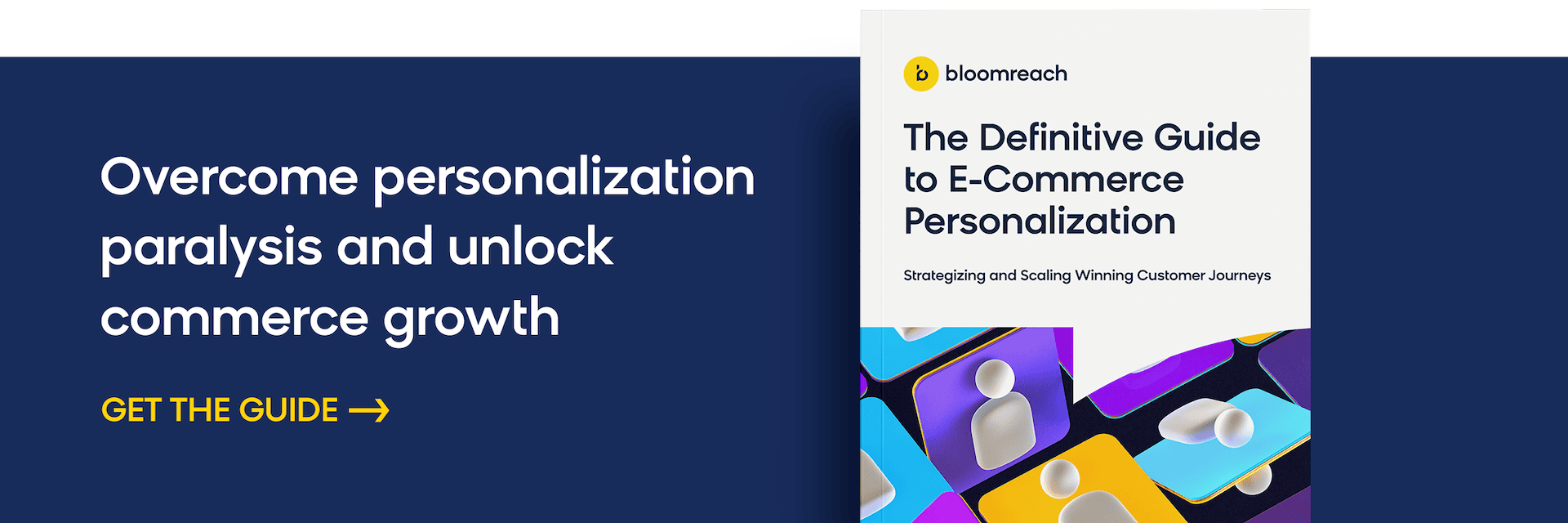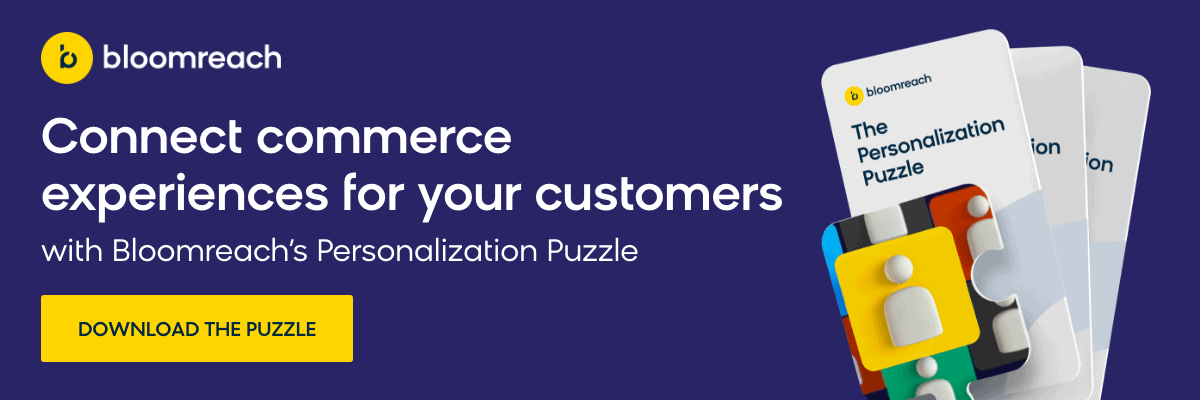While there are dozens of different maturity models on the market that try to explain the different levels of ecommerce personalization and how to climb the ladder to success, we at Bloomreach believe that the best way to measure personalization success is by visualizing it like a puzzle.
Every piece of your personalization puzzle is important. While you can look at it as something composed of individual pieces, what’s ultimately most important is the final connected picture. This means that even if you have all the right pieces, if you arrange them into an image that doesn’t make sense, you’ll see little to no results.
What is the image that makes sense for your company? It’s likely a combination of micro-level victories (increases in key metrics such as open rate, conversion rate, etc.) and macro-level victories.
Why Ecommerce Personalization Matters
Each piece of your company’s personalization puzzle provides an example of how you’ve used commerce data to improve customer experiences. When you do this, it inevitably leads to digital commerce success because you’ve made the customer experience better.
When Bloomreach CEO Raj De Datta founded the company in 2009, it was with the belief that customers wanted and deserved incredible online experiences, and that personalization was the key to achieving them. Brands that have put personalization at the heart of their digital experience are not only seeing positive business results, they’re also delivering the type of experience customers have long been seeking—the type of experience that builds true brand loyalty.
“For years, digital commerce was simply about standing up a store,” De Datta explains. “Today, it’s about standing out. Personalization at scale allows a business to unlock the next level of ecommerce growth by offering a digital experience that feels catered to each consumer. In tapping into the unified power of customer and product data, brands now have the ability to engage, inspire, and convert consumers in a truly memorable way. And it’s that kind of experience that convinces the consumer to engage with a brand again and again.”
If your company is new to personalization and this is sounding a little overwhelming, don’t worry. The hardest part of adopting any new e-commerce strategy is the initial planning around how to adapt the strategy perfectly to your brand.
Personalization is no different. It takes a commitment from the whole company to do it the right way. These seven steps will help serve as a roadmap as you begin your personalization pursuits.
The 7 Steps to Personalization
Step 1: Identify
Specifically, identify where and how you want to personalize your website or your marketing communications for visitors.
This decision should of course be made with the customer in mind. Where can you create personalized experiences for customers that bring them joy and encourage them to stay loyal to your brand?
Step 2: Research
Gather as much information as you can about ecommerce personalization technologies, what they do, and how they fit into your company goals and previously identified plan.
Full-site personalization and personalized automated marketing campaigns are not only possible in today’s market, they are almost expected by the modern customer. Choose a vendor that is committed to facilitating personalization at scale and has a proven track record of providing value to ecommerce customers.
Step 3: Allocate
Ensure that your company is able to assign enough resources to the project at hand. And don’t just think of resources in terms of finances or money.
Deciding who should oversee the project and how gains will be measured are just two of many extremely important choices that must be made. If your commerce-driving team is as diverse as many are, ensure that you have representatives from marketing, merchandising, and CRM roles to give input.
Step 4: Define
Personalization efforts require a long-term vision and optimization process. Define that vision and process here with your commerce-driving team.
Specifically, consider what your long-term goals with personalization are. Perhaps find a company in a different vertical that’s excelling in personalization that you can emulate or follow in the steps of.
Step 5: Start
Since your research is done and your vision and goals are in place, it’s time to begin the actual work.
Start to segment and personalize your site and marketing communications. Take careful note of which areas of your site benefit the most from personalization and which key metrics improve with your marketing campaigns.
Step 6: Continue
Keep going! If you’re getting the results that you hoped for, continue doing what you’re doing.
If you’re not, re-assess and optimize the process as needed. Making changes to the original strategy can be very beneficial if those changes are data-driven and you believe they can help improve your metrics. Continue monitoring, tweaking, and recording the data until you have something that you are fully happy with.
Step 7: Scale
Now it’s time to do it big. You’ve made all of the necessary adjustments and you should have 100% confidence in your personalization strategy and the ability to recreate your positive results at scale.
Scale your personalization efforts across all of your existing channels — maybe even add a few new ones while you’re at it. Ensure your commerce-driving team stays as connected as possible, as scaling can be taxing on the team.
Ecommerce Personalization Starts with Bloomreach
Every company started somewhere with ecommerce personalization — that includes personalization giants like Netflix and Spotify.
Our recommendation? Start with Bloomreach. Our Commerce Experience Cloud is the perfect roadmap to guide your company on its journey with ecommerce personalization.
Our Content, Discovery, and Engagement platforms will allow you to fix the fractured customer journey and implement a unified solution that offers full-site personalization options.
With Bloomreach Engagement, marketers can unify all of their customer data and deliver connected customer experiences with a single solution. Bloomreach Discovery offers search and merchandising, SEO, and recommendations and pathways to facilitate your customers having a personalized experience on your website. Finally, Bloomreach Content is a headless content management system that allows you to personalize content and products to get the best conversion rates possible.
Together, these three platforms comprise the Bloomreach Commerce Experience Cloud, the missing piece to your ecommerce personalization puzzle.
For even more tips, be sure to check out our Definitive Guide to Ecommerce Personalization. You’ll get an in-depth look at how to unify your commerce-driving team behind key concepts of ecommerce personalization and ensure they’re doing all they can to provide a connected commerce experience to your customers.















